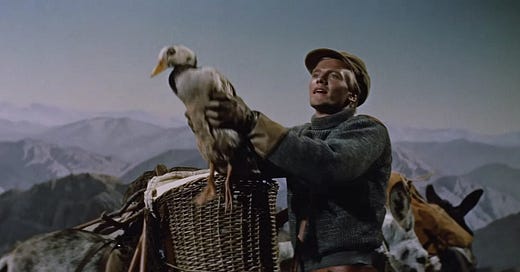Gertrude the duck
I first saw Henry Levin’s Journey to the Center of the Earth when I was in elementary school in the late 1990s. My family was living outside San Francisco. On weekends, we’d rent movies from a video-store clerk with enormous ear gauges to watch together.
Often these would be new films. For instance, I have a clear memory of my father, an avid mountaineer, guffawing as Brad Pitt’s character from Seven Years in Tibet escaped a pair of guards by encouraging them to wear his unwieldy crampons.
Just as often, however, we’d watch old movies. Both of my parents contributed to my cinematic education in this respect. At that point, my mother was working on a biography of the actor Spencer Tracy, a star from Hollywood’s Golden Age.
Many of her selections came from Tracy’s filmography. Additionally, we often watched movies featuring important figures in her subject’s life, such as Katharine Hepburn and James Cagney, even if they didn’t include Tracy.
My dad’s picks had a less obvious through line. For instance, I believe The Maltese Falcon, Butch Cassidy and the Sundance Kid, and American Graffiti were all his. These included a noir, a western and a coming-of-age story.
I think Levin’s 1959 science-fiction title was one of my father’s choices as well. Given the year of its release, I suspect Dad saw the adaption of Jules Verne’s novel as a child and it left some kind of impression on him. But I’m not sure.
My only recollection of watching the film was being horrified when one human character kills and eats another’s pet duck. Of course, I ate meat at the time. I’d say this feeling presaged my animal activism, but I suspect it was a common response.
I recently returned to the movie after more than 25 years. James Mason stars as the leader of an expedition which seeks, as the film’s name suggests, to journey to the center of the earth. Pat Boone, Peter Ronson and Arlene Dahl round out the main cast.
Ronson plays Hans Bjelke, an Icelandic duck hunter who serves as the expedition’s guide. Early in the movie, we see his feather storehouse, which is so full Mason’s character can practically swim in it. Oddly, Bjelke has adopted one duck as a companion, who he calls Gertrude.
The hunter is portrayed as eccentric. Still, this contradictory understanding of animals — as resources in some instances and beloved individuals in others — is shared by the overwhelming majority of human society. Levin’s choices exacerbate the contradiction.
Thayer David plays Count Saknussemm, the film’s villain. The scene in which Bjelke discovers Saknussemm killed Gertrude is arguably the most intense in the whole picture. Music thunders. Bjelke tries to strangle Saknussemm. Finally, the guilty man trips and falls to his death.
Again, I don’t think my childhood reaction was unusual. I believe it was the intended one. By this point in the movie, even Mason’s gruff Oliver Lindenbrook has come to see Gertrude as a unique personality. He accounts for her as he does other members of the expedition.
I assume the animal or animals who played Gertrude were treated terribly. My wish would be all such nonhuman ‘actors’ were replaced by computer-generated imagery or puppets. However that’s a different conversation.
In a contemporary review of the film, New York Times critic Bosley Crowther was unimpressed. “It’s really not very striking make-believe, when all is said and done,” he wrote. “The earth's interior is somewhat on the order of an elaborate amusement-park tunnel of love.”
Perhaps I’m holding 1950s science fiction to a condescendingly low standard, but I find such flaws to be charming. It was nice to revisit Journey to the Center of the Earth.


